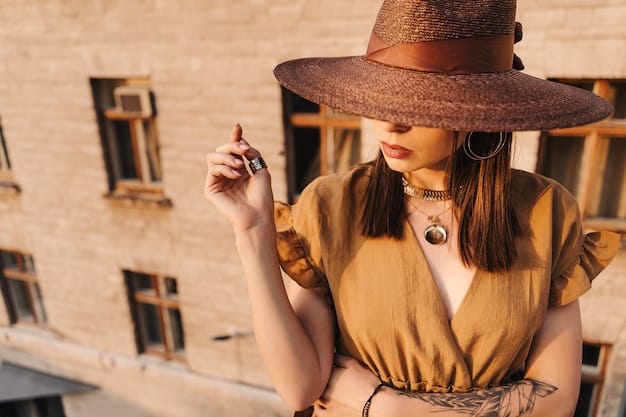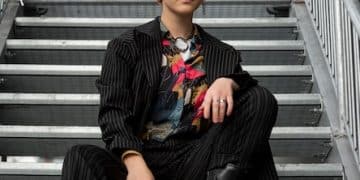Decoding Non-Binary Fashion: Layering Techniques for Everyone

Decoding Non-Binary Fashion: 5 Insider Tips to Mastering Layering Techniques provides a comprehensive guide to creating versatile, expressive, and authentic looks that transcend traditional gender norms, empowering individuals to embrace their unique style through effective layering.
Unlock the secrets of non-binary fashion with expert tips on layering. Discover how to express your authentic self through versatile and stylish outfits, breaking free from traditional gender norms. Decoding Non-Binary Fashion: 5 Insider Tips to Mastering Layering Techniques will guide you.
Understanding the Essence of Non-Binary Fashion
Non-binary fashion is more than just clothing; it’s a powerful form of self-expression. It’s about breaking free from the rigid constraints of traditional gender norms and embracing a style that truly reflects your identity. Understanding the core principles of this approach is crucial for crafting a wardrobe that resonates with your authentic self.
What Defines Non-Binary Style?
At its heart, non-binary style is about freedom and fluidity. It’s a rejection of predefined rules and expectations, allowing individuals to explore and express their gender identity in a way that feels genuine and empowering. This approach prioritizes comfort, personal preference, and the celebration of individuality.
Key elements of non-binary style include:
- Versatility: Pieces that can be mixed and matched to create a variety of looks.
- Neutrality: Garments that don’t conform to traditional gendered silhouettes or colors.
- Comfort: Prioritizing fabrics and fits that feel good on the body.
- Individuality: Expressing personal interests and preferences through clothing.
Layering as a Tool for Self-Expression
Layering is a powerful technique in non-binary fashion because it allows for endless customization and the creation of unique silhouettes. It enables you to play with proportions, textures, and colors, constructing outfits that reflect your mood and personality. Layering provides opportunities to add or remove pieces, adapting your look to different environments and situations.

By understanding the essence of non-binary fashion and embracing layering as a creative tool, you can begin to build a wardrobe that is both authentic and stylish. This approach empowers you to confidently express your identity and navigate the world on your own terms.
Tip #1: Mastering the Art of Proportions
Playing with proportions is a fundamental skill in fashion, especially when exploring non-binary styles. It allows you to create visually interesting and balanced outfits that defy traditional silhouettes. Experimenting with different lengths, volumes, and shapes can result in truly unique and expressive looks.
Oversized vs. Fitted: Finding the Right Balance
One of the key aspects of mastering proportions is understanding how to balance oversized and fitted pieces. An oversized top can be paired with fitted pants to create a relaxed yet defined silhouette. Conversely, fitted tops can be layered under oversized jackets or sweaters for added dimension.
Consider these examples:
- A flowing tunic worn over slim-fitting jeans or leggings.
- A tailored blazer layered over a loose-fitting t-shirt and wide-leg trousers.
- A cropped sweater paired with high-waisted, wide-leg pants.
Lengthening and Shortening: Creating Visual Interest
Manipulating the length of your garments can also significantly impact your overall look. Layering shorter pieces over longer ones, or vice versa, can create visual interest and add depth to your outfit. This technique is particularly effective for creating androgynous or gender-neutral styles.
Here are some ideas to try:
- A short denim jacket layered over a long, flowing dress or skirt.
- A cropped vest worn over a button-down shirt with long sleeves.
- An elongated t-shirt layered under a shorter, boxy sweater.
Experimenting with proportions is an ongoing process of discovery. Don’t be afraid to try new combinations and push the boundaries of traditional style. By mastering this skill, you can create outfits that are both visually appealing and authentically you.
Tip #2: The Power of Textures and Fabrics
Beyond color and silhouette, the textures and fabrics you choose play a significant role in defining your style. Combining different textures can add depth, interest, and a tactile dimension to your layered looks. Experimenting with various fabrics allows you to create outfits that are visually engaging and comfortable to wear.
Mixing and Matching Textures for Depth
Contrast is key when it comes to mixing textures. Pairing smooth fabrics with rough ones, or soft materials with structured ones, creates a dynamic interplay that elevates your overall look. This technique adds complexity and visual interest, making your outfit more compelling.
Consider these texture combinations:
- Denim and lace for a rugged yet delicate contrast.
- Leather and silk for a luxurious and edgy feel.
- Knitwear and chiffon for a cozy and airy combination.
Fabric Weight and Seasonality
When layering, it’s important to consider the weight and seasonality of your fabrics. Lighter fabrics like cotton and linen are ideal for warmer weather, while heavier fabrics such as wool and corduroy are better suited for colder months. Layering different weights of fabric allows you to adapt your outfit to changing temperatures and create comfortable, stylish looks year-round.

Experiment with layering lightweight fabrics over heavier ones, or vice versa, to create visually interesting and functional outfits. For example, a sheer blouse layered under a wool sweater can add a touch of femininity to a cozy winter look. By paying attention to the textures and fabrics you choose, you can create layered outfits that are both stylish and comfortable.
Tip #3: Color Palettes and Harmony
Choosing the right color palette is essential for creating cohesive and visually appealing layered outfits. Understanding color theory and how different colors interact with each other can help you create harmonious combinations that express your personal style. Whether you prefer bold and vibrant hues or subtle and muted tones, a well-chosen color palette can elevate your look.
Monochromatic Magic: Exploring Shades and Tones
A monochromatic color palette, which involves using different shades and tones of a single color, can be a sophisticated and easy-to-execute option for layering. This approach creates a sense of unity and calmness, allowing you to focus on textures and silhouettes. Monochromatic outfits can be surprisingly versatile and impactful.
Try these monochromatic combinations:
- Different shades of grey, from light heather grey to dark charcoal.
- Variations of blue, from pastel sky blue to deep navy.
- A range of earthy tones, from beige and khaki to chocolate brown.
Complementary Colors: Creating Bold Statements
Complementary colors, which are opposite each other on the color wheel (such as red and green, or blue and orange), can create bold and eye-catching contrasts in your layered outfits. However, it’s important to use complementary colors judiciously, as they can be overwhelming if not balanced properly. Consider using one color as the dominant hue and the other as an accent.
By understanding the principles of color theory and experimenting with different palettes, you can create layered outfits that are both harmonious and expressive. Don’t be afraid to step outside your comfort zone and explore new color combinations. The possibilities are endless!
Tip #4: Accessorizing Strategically
Accessories are the finishing touches that can transform a layered outfit from ordinary to extraordinary. They provide opportunities to add personal flair, refine your silhouette, and enhance your overall look. When accessorizing, it’s important to be strategic and intentional, choosing pieces that complement your outfit and reflect your individual style.
Belts, Scarves, and Hats: Defining Your Silhouette
Belts, scarves, and hats are versatile accessories that can be used to define your silhouette and add visual interest to your layered outfits. A belt can cinch in a loose-fitting top or dress, creating a more defined waistline. A scarf can add a pop of color or texture to your neckline, while a hat can provide shade and add a touch of personality. Consider these possibilities:
- A wide belt worn over a long cardigan or tunic.
- A silk scarf knotted loosely around the neck or tied in the hair.
- A wide-brimmed hat or a beanie worn to add a touch of edge to your ensemble.
Jewelry and Body Art: Expressing Your Personal Style
Jewelry and body art (such as tattoos or piercings) are powerful tools for expressing your personal style and adding a unique touch to your layered outfits. Choose pieces that reflect your interests, values, and personality. Mix and match different styles of jewelry to create a layered effect, or showcase your tattoos and piercings with carefully chosen garments.
Consider: Layering delicate necklaces of varying lengths to create a focal point at your neckline. Wear multiple rings on your fingers to express your individuality. Showcasing your tattoos with sleeveless tops or cropped pants.
By accessorizing strategically, you can elevate your layered outfits and express your unique personality. Don’t be afraid to experiment with different styles and find pieces that resonate with your authentic self.
Tip #5: Confidence is Your Best Accessory
Ultimately, the most important element of any outfit, especially in non-binary fashion, is confidence. No matter how skilled you are at layering or how carefully you choose your accessories, if you don’t feel confident in what you’re wearing, it will show. Embracing your unique style and owning your look is the key to pulling off any outfit with flair and authenticity.
Owning Your Look: Embracing Individuality
Confidence comes from accepting and celebrating your individuality. Don’t be afraid to break the rules, experiment with different styles, and express yourself in a way that feels genuine. Non-binary fashion is all about freedom and self-discovery, so embrace the opportunity to explore and define your own personal style.
Finding What Makes You Comfortable
Comfort is another crucial factor in building confidence. Choose garments that fit well, feel good on your body, and allow you to move freely. When you’re comfortable in your clothes, you’re more likely to feel confident and relaxed, which will radiate outwards.
Remember that fashion is a form of self-expression, not a competition. Focus on creating outfits that make you feel good about yourself, and don’t worry about what anyone else thinks. When you’re confident and comfortable in your own skin, you’ll shine from the inside out.
| Key Point | Brief Description |
|---|---|
| ✨ Proportions | Balance oversized with fitted items for unique silhouettes. |
| 🧵 Textures | Combine different fabrics for depth and visual appeal. |
| 🎨 Color Harmony | Use monochromatic or complementary palettes effectively. |
| 💎 Accessories | Strategically accessorize to define your style and silhouette. |
Frequently Asked Questions
▼
Non-binary fashion is about expressing yourself outside traditional gender norms, focusing on personal style and comfort rather than conforming to societal expectations.
▼
Layering allows you to adapt your look, add depth, and create unique silhouettes that reflect your identity, mixing and matching to express yourself freely.
▼
Fabrics depend on the season, with lighter options like cotton for summer and heavier ones like wool for winter. Combining different textures enhances your style.
▼
Belts, scarves, hats, and jewelry can define your silhouette and express personality. Choose accessories that resonate with your interests and personal style.
▼
Confidence is key. Embracing your individuality and feeling comfortable in what you wear is crucial for expressing your authentic self in non-binary fashion.
Conclusion
Mastering layering techniques is a powerful way to express your non-binary style, allowing for endless creativity and self-discovery. By understanding proportions, textures, colors, and the importance of accessories, you can create outfits that reflect your unique identity and boost your confidence. Embrace the freedom to experiment and define your own personal style, breaking free from traditional gender norms and celebrating your authentic self through fashion.





